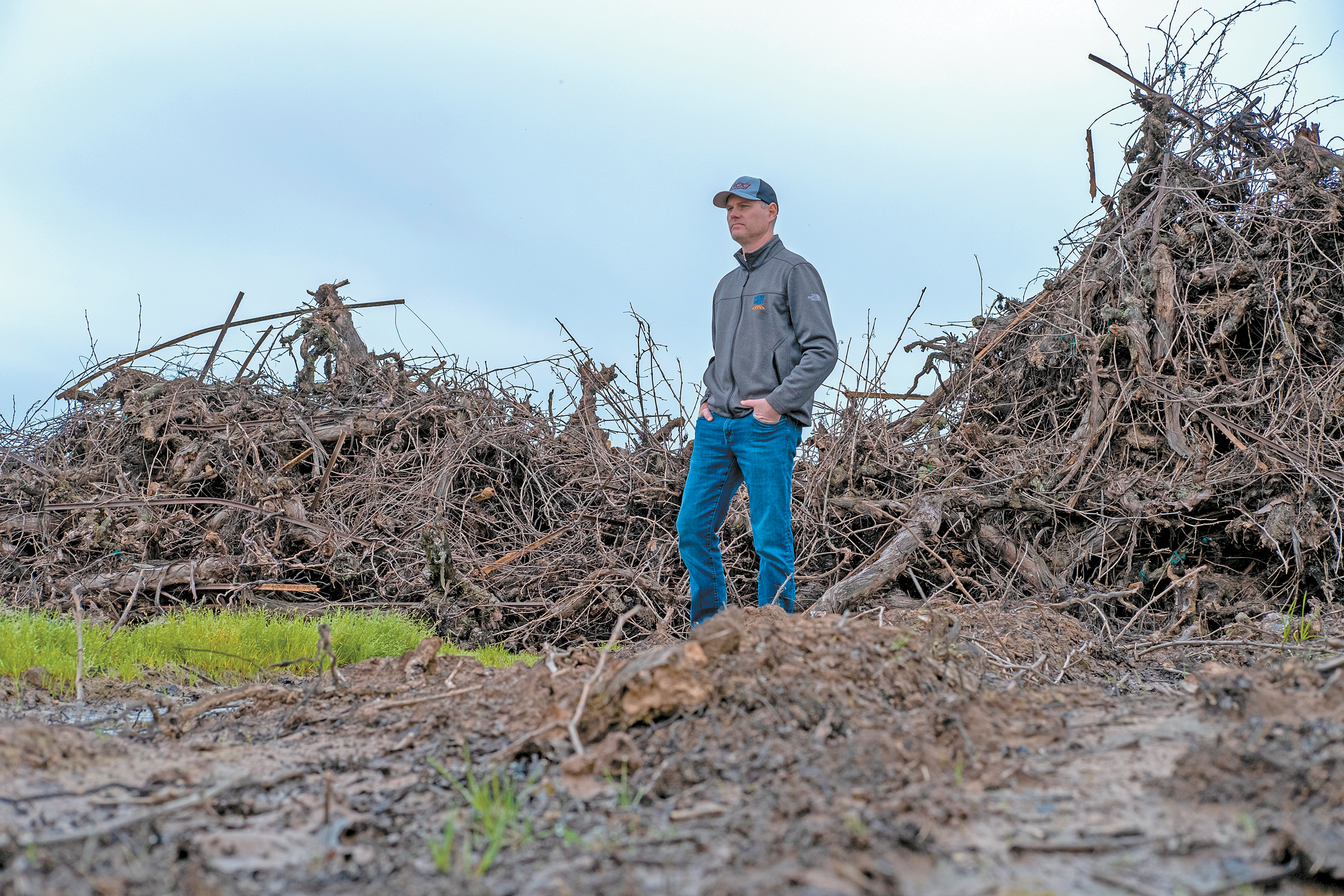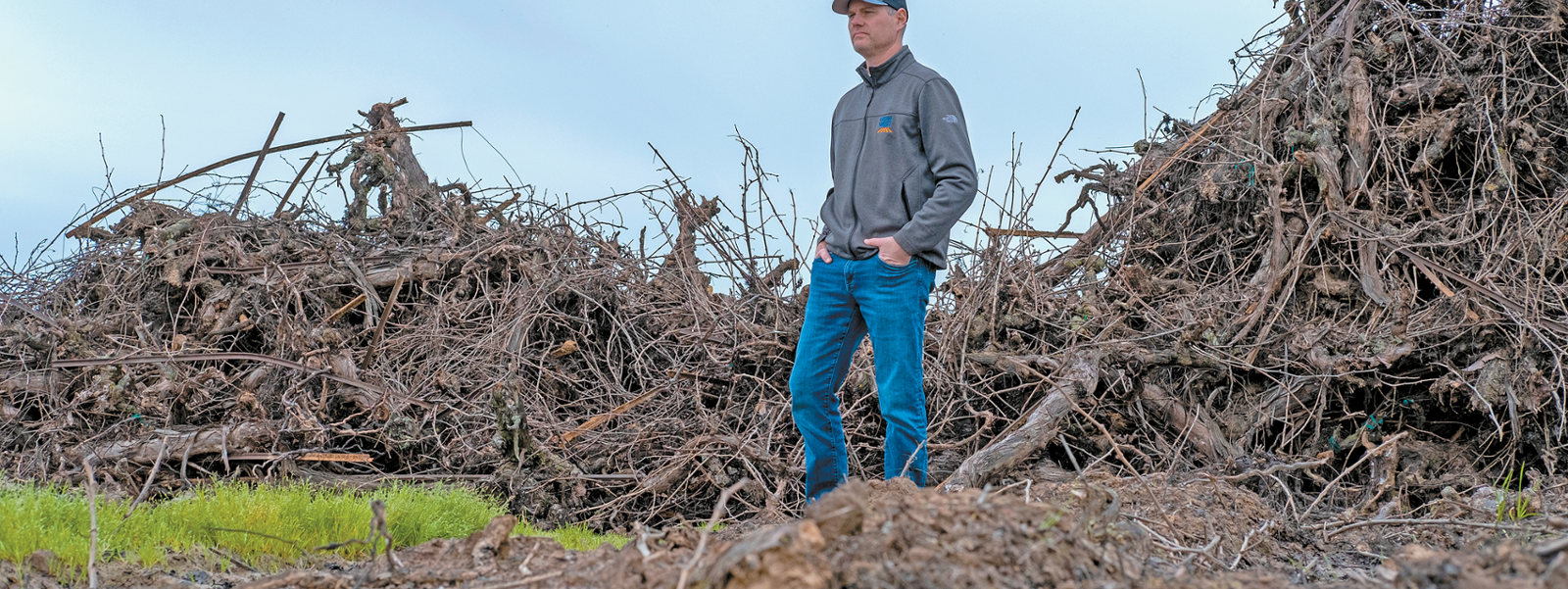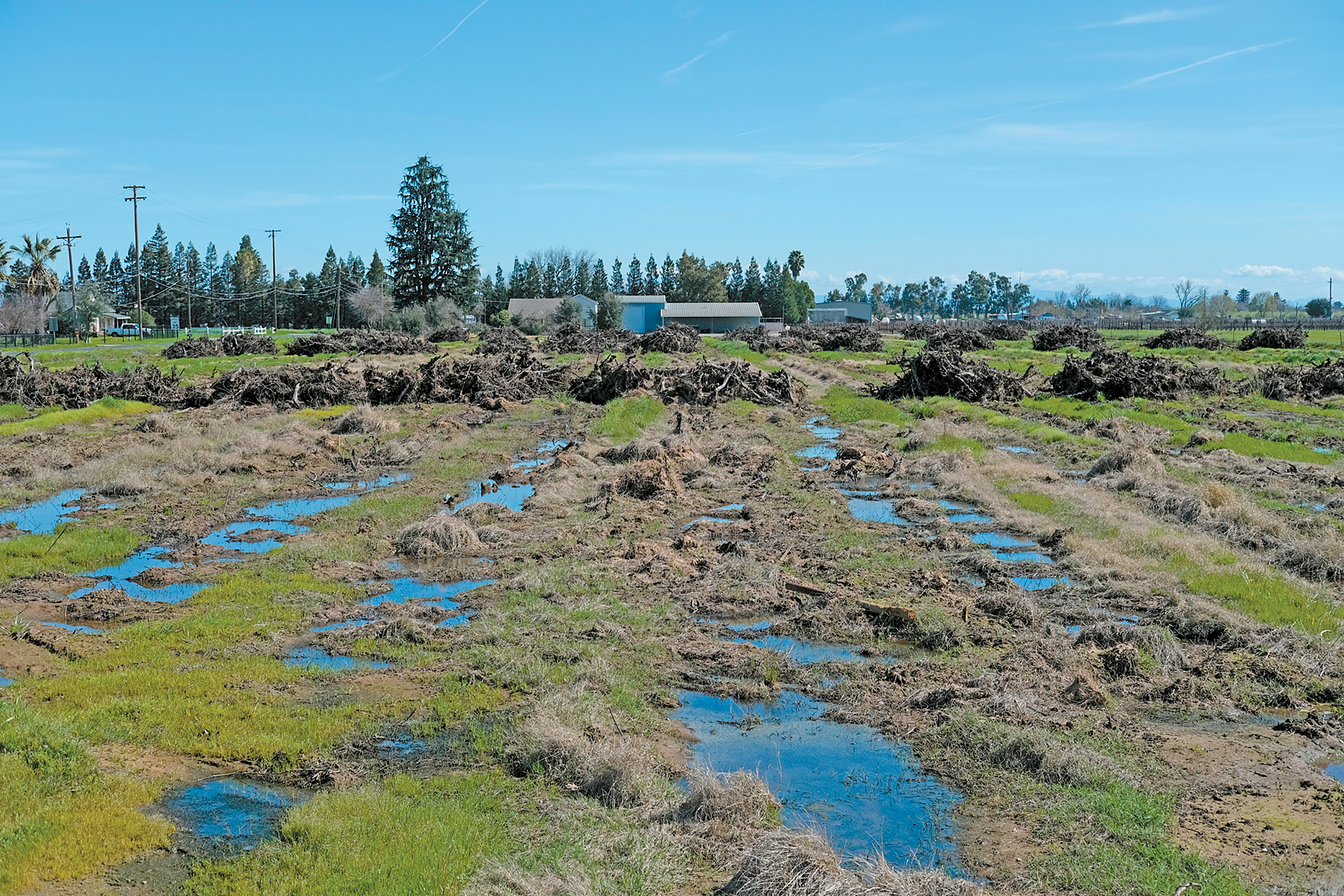Growers scrap vineyards as market dims

Aaron Lange, vice president of vineyard operations at LangeTwins Winery and Vineyards in the Lodi area, has removed 400 acres of vineyards this winter. Across California, growers are tearing out vineyards to reduce the state’s winegrape-bearing acreage in response to declining wine sales.
Photo/Caleb Hampton


Photo/Caleb Hampton
By Caleb Hampton
A once-in-a-generation downturn in the wine market is reshaping California’s grape-growing regions as farmers tear out vines to rebalance supply with declining demand.
Throughout this winter, bulldozers plowed through Lodi’s wine country, leveling vineyards and piling vines in mangled heaps on either side of Highway 99 in San Joaquin County. Thousands of acres in the region have been removed or are slated for removal, according to an ongoing survey of its members by the Lodi District Grape Growers Association.
“There are significantly more pullouts than happen in a normal year,” said Amy Blagg, the association’s executive director.
Winegrape growers typically sign pre-plant contracts with wineries to plant and farm a vineyard block for 10 years or longer, and then negotiate new shorter-term contracts for that block or sell uncommitted grapes on the spot market. Old or out-of-contract vineyards are removed for various reasons or when no longer profitable.
One Lodi-area grower said he was taking out more acres this winter than ever before. Another said the need to remove vines was greater and more urgent now than at any point in his lifetime or his parents’.
After decades of growth, U.S. wine sales slowed around 2013 before declining steadily for the past three years. Statewide, industry leaders have called for growers to remove some 50,000 acres—around 9% of California’s winegrape-bearing acreage—to achieve market balance.
“We’re structurally oversupplied,” said Jeff Bitter, president of Allied Grape Growers. “We have to adjust our acreage down.”
Last year, the excess supply caused wineries to raise quality standards for grapes, lower prices and buy less on the spot market. As a result, Bitter said, “significant tons” of uncommitted fruit went unharvested across the state.
James Renton, owner of Harris Vineyards in the Lodi area, farmed 125 acres of cabernet sauvignon and zinfandel last year, investing in labor and materials only to watch the grapes rot because no one bought them. “I just dumped them on the ground,” said Renton, who grows about 750 acres of winegrapes.
He tore out the cabernet sauvignon vineyard in December. A couple weeks ago, he decided to take out the zinfandel, too. “I kept waiting for somebody to offer me a contract,” he said, “but it just doesn’t seem like there’s any hope.”
Eventually, reducing supply through vineyard removals should ease the pain caused by a contracting market. But reaching that point may bring more suffering. With bud break approaching, some growers are sounding an alarm that they can’t get their vines out fast enough.
“It’s a big mad rush,” said Randy Baranek, project manager for Fowler Brothers Farming, a contractor that removes vineyards.
Growers usually remove vineyards during the dormant season. In early April, they start pest-control applications to prevent outbreaks that can jump from one vineyard to the next. “There’s a certain point at which that growing vineyard becomes a problem,” Bitter said.
There are fears that if growers cannot get vineyards removed in time, pests and diseases could take hold in abandoned vineyards and spread. “If guys quit spraying for mildew and mealybugs, that could get out of control,” Renton said.
The risk may be especially great in the Lodi area—by tonnage, the nation’s top winegrowing region—where in recent years growers have seen mounting pest and disease impacts. Unlike further south in the valley, there are fewer orchards and field crops to serve as barriers between blocks of winegrapes.
“We have a very concentrated area of vineyards,” Blagg said. “How you manage your own vineyard impacts your neighbors.”
Aaron Lange, vice president of vineyard operations at LangeTwins Winery and Vineyards in the Lodi area, removed 400 acres this winter and was still waiting on a contractor to tear out an old block of cabernet sauvignon. Expecting a monthslong wait, Lange said he planned to spray it to protect a neighboring block of cabernet franc. “That’s going to be money we’re throwing down the drain,” he said.
But devoting financial resources to condemned vineyards is a “big ask” to make, he said, especially with some growers experiencing setbacks from increased farming costs and unsold grapes.
Compounding the challenges for growers in the eight-county San Joaquin Valley Air Pollution Control District are new restrictions on agricultural burning that have made it slower and more expensive to remove vines.
Until recently, if a grower wanted a vineyard out, “you pushed it over, piled it up and lit it on fire,” Bitter said.
Beginning this year, growers with more than 100 to 250 acres, depending on the trellis system, can no longer burn their vineyards. Instead, they must hire labor crews to extract the metal wires embedded in vines. Contractors then use heavy machinery to pile the vines and dump them into a grinder or an air curtain burner.
“It’s a lot more expensive,” said Donald Wortley, owner of DSW Ag, who has removed vineyards for Lodi-area growers for more than 50 years.
In 2018, the air district launched the Alternative to Open Ag Burning Incentive Program, offering farmers grants of $500 to $1,700 per acre to offset some of the cost of vineyard removal during the phaseout.
But cost is only one obstacle. The amount of acreage growers want removed has overwhelmed the capacity of contractors that remove vineyards. “Right now, everyone is backed up,” Wortley said.
Baranek, the Fowler Brothers manager, said he had received as many as five times more removal requests this winter as in a typical year. He said last week he had a waitlist that would take him six to eight weeks to work through—or longer, depending on weather—and continued to get new requests every day.
“It’s a perfect storm,” Lange said, referring to the timing of market-related vineyard removals, the burning phaseout and wet weather that prevented contractors from getting their equipment into Lodi-area vineyards in recent weeks.
In the future, growers expect it may only get harder to take out vineyards. Next year, as the phaseout reaches completion, open burning will be prohibited even for small growers, and continued grant funding for alternative methods is uncertain.
An initial $178 million provided by the state budget in 2021 to fund the incentive program was exhausted, air district officials told growers at an informational meeting in Lodi last week.
In January, the air district’s governing board allocated $10 million to keep the program afloat, using funds from its operating budget. The same month, the district reduced the maximum acreage a grower can get funding for—from 500 to 250 per year—in an effort to stretch those funds.
Crystal Yunker, supervising air quality specialist for the district, told growers the agency is hoping to get at least $20 million in Community Air Protection funds for the program from the state in April, and may allocate more of its own funds in July.
Meanwhile, with bud break weeks or days away, vineyard-removal contractors said calls from growers were only ramping up as farmers got word from wineries that their contracts would not be renewed.
“It’s going to get really busy here,” said John Yergat, president of JFS Enterprises, a contractor that removes vineyards, speaking about an uptick in calls from Lodi-area growers in recent weeks. Bitter estimated some growers could be kept waiting until June or July to get their vines out.
“There are going to be hundreds if not thousands of acres of vineyards that growers wanted to remove but they couldn’t get a contractor and equipment in there in time,” Lange said. “We’re headed towards a brick wall.”
(Caleb Hampton is an assistant editor of Ag Alert. He may be contacted at champton@cfbf.com.)




